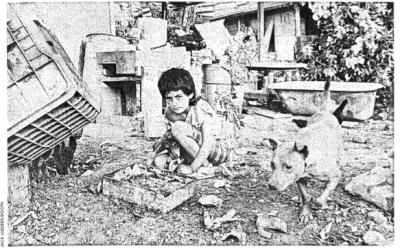Poverty Blocks Economic Growth
Latin America is not the poorest region in the world. On average, most of Africa, Eastern Europe, and Asia are poorer. But Latin America is the world’s most unequal region. Income and wealth are concentrated at the top; much less trickles down to the bottom than elsewhere.
These inequalities, however they are measured, represent an historic failure of truly epic proportions. Most of the Latin American countries now produce enough goods and services to lift most of their poor citizens out of extreme poverty and malnutrition. At comparable level of GDP per capita, other world regions have done so.
Of the Latin America’s 480 million inhabitants, more than 200 million, 38 percent of the region’s population, live in “poverty,” according to official statistics. Of that number, at least 100 million are “indigent,” so poor that if they spent their entire income on food, they would still lack essential nutrition. More than half of all rural people in Latin America are indigent.
Inequality can be measured in many ways. One way is to look at the ratio of the earnings of the top 20 percent of income earners to the bottom 20 percent. In Sweden, Taiwan, and Cuba, the top 20 percent make four to five times on average as much as the bottom 20 percent. In the United States, the ratio is about 4 to 1. In Latin America the average is approximately 15 to 1. In some Latin American countries, like Brazil, Panama, and Guatemala, it’s over 30 to 1.
Another way of measuring inequality is to look at the distribution of assets. Assets can be tangible wealth, like real estate and stocks, or the “human capital” created by education. Wealth and human capital are also highly concentrated Latin America.
When income and assets are more concentrated, poverty increases. That is, at any given level of productivity (GDP per capita), a Latin American country will have more poverty than a less unequal country elsewhere.
It is true, however, that similar conditions once afflicted many of today’s developed countries. The Industrial Revolution of the nineteenth century raised GNP but initially lowered living standards. In the United States, for example, the decline in the physical welfare of the population was visible to the naked eye. The average height of adult native-born males fell by five centimeters beginning with the cohort born in the 1790s. North Americans did not recover their 1790 stature until the 1920s.
Like the United States, many European and Asian countries also experienced prolonged periods of declining or stagnant living standards during the early stages of economic growth. Unlike these other regions, however, the Latin America countries have yet to make the transition to more equitable distribution and less poverty. Latin America remains locked into higher levels of inequality and poverty at much higher levels of per capita GNP than any other region.
Most governments did not start collecting data on income distribution or poverty until sometime in this century. For earlier centuries, historians now use data on the average (mean) height or stature of a population. Stature provides an excellent measure of “net nutrition” that is, total or gross nutrition minus what is needed to ward off disease and work for a living. This is because human stature at equal levels of net nutrition does not vary from one racial or ethnic group to another (even though individual height can vary).
The widespread myth in Latin America that indigenous peoples are genetically shorter than Europeans or mestizos is false. Differences in height between population groups are due mainly to differences in net nutrition, especially in the first three years of childhood and during adolescent growth spurts. Where children and adolescents are exposed to more disease, lack access to adequate medical care, or engage in stressful or strenuous work, more nutrition is needed to achieve the same stature.
Differences in the stature of racial, ethnic, and social groups in Latin America, like anywhere else, are mainly attributable to differences in net nutrition. Such differences used to be common in today’s developed countries. In 1800, the titled nobility of England stood a full five inches taller than the English population as a whole. Today, the difference is less than one inch and scarcely noticeable. Aristocrats and commoners are both taller today than in 1800, but the benefits of better diet were concentrated at the lower end of the income scale.
In 1800, the English population consumed a little more than 2,000 calories per day, slightly less than the average for Latin America today. At this level, historians have estimated that roughly 20 percent of the adult population was too malnourished to work. Of the 80 percent available for work, most could not have worked at anything like the intensity of the modern workplace.
Improved nutrition helped fuel the British economy. Economic historian Robert William Fogel, in his Nobel Prize Lecture in 1994, estimated that 30 percent of the increase in the per capita product of Great Britain between 1790 and 1980 was due solely to improvements in gross nutrition. Improvements in public health and access to medical care made additional contributions to growth by enabling people to use more calories for work because they needed fewer to fight disease.
Economists and policymakers usually see poverty reduction as important for reducing the risk of violence or political instability, easing pressures for inflationary increases in government spending, and broadening markets for manufactured goods. Historical calculations like those of Fogel suggest that poverty reduction may be crucial in much more direct ways to achieving economic growth. With a large proportion of the population too poorly nourished to work or to work at modern levels of intensity, economic growth in Latin America could be held back for many years to come unless governments in the region develop more effective ways of reducing poverty than they have yet implemented.
Conversely, relatively small steps to reduce inequality by raising the income of the poorest citizens in the region could produce large improvements in their physical welfare and contribute disproportionately to economic growth. Such improvements could be achieved directly through income transfers (pensions, poor relief, food stamps, nutrition supplements) or indirectly through increased investment in education, public health, medical attention for vulnerable populations, and the like.
In much of the region, however, public expenditures on social programs have not yet recovered to the per capita levels achieved before the financial and economic crisis of the early 1980s. Nor has the long-awaited “second generation” of reforms to make government more efficient and effective in its core functions yet to produce many results.
The restoration of democratic regimes in the 1980s coincided with enormous progress in opening markets, containing inflation, and eliminating wasteful subsidies to inefficient public enterprises. But the region’s historic failure to invest adequately in its own people continues to act as a drag on economic growth.
Spring 1998
John H. Coatsworth is Monroe Gutman Professor of Latin American Affairs and director of the David Rockefeller Center for Latin American Studies.
Related Articles
The Social Agenda in Latin America
If the 1980s were the era of economic policy reform in Latin America, the 1990s have become the era of social sector reform. Indeed, a consensus is now forming that delivery of health care…
A Mellon Update
More than 23 Latin American archives and libraries from Mexico to Rio de Janeiro have received grants from the Andrew W. Mellon Foundation to upgrade or preserve their facilities. The…
From Havana to HUD
Kennedy School Assistant Professor Xavier de Souza Briggs, who took a group of 17 graduate public policy students on a one-week study tour of Cuba last year, has now embarked on…




